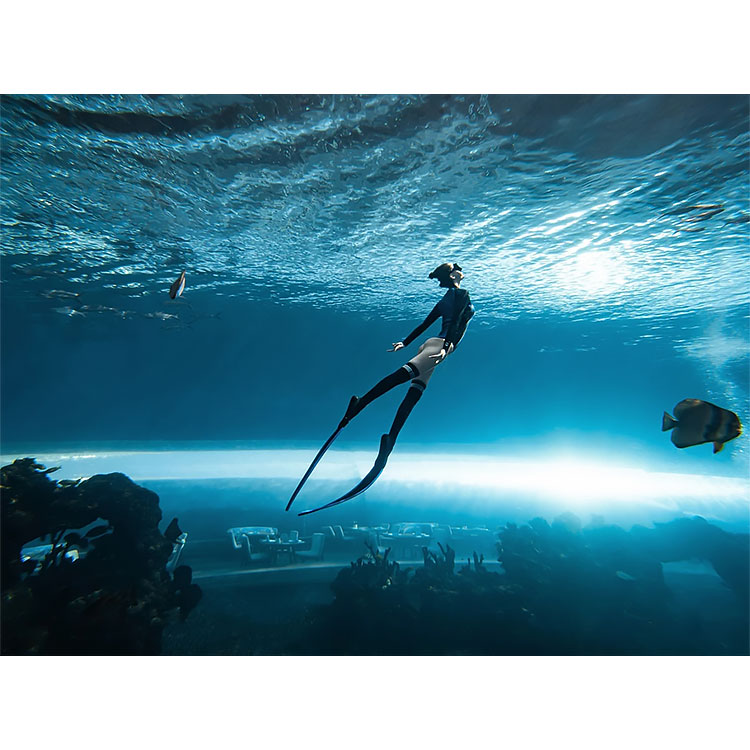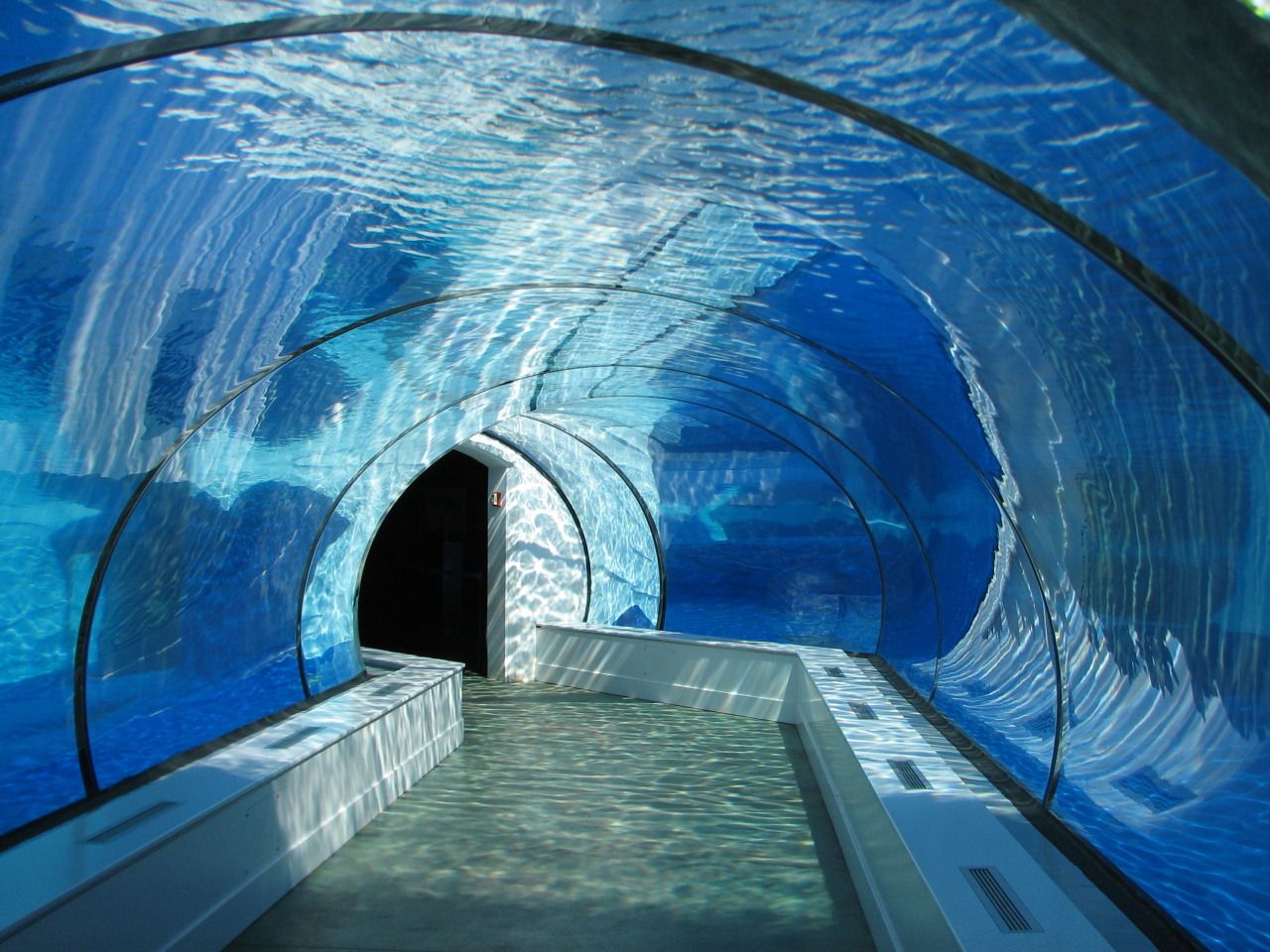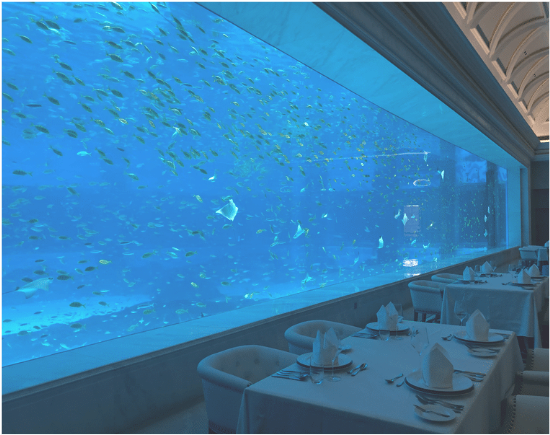Do you know what an aquarium tunnel is? - Leyu specializes in making acrylic aquarium tunnels
Do you know what an aquarium tunnel is?The construction of tunnel aquariums typically involves the creation of a large, transparent acrylic tunnel or tube that is able to withstand the pressure of the water surrounding it. The aquarium tunnel is then placed into a large tank or pool filled with water, with the ends of the acrylic tunnel being securely sealed to prevent leaks.
The aquarium tunnel is often made of materials such as acrylic , which are able to withstand the water pressure and provide a clear view of the aquatic life inside. The size and shape of the acrylic tunnel can vary depending on the desired design and the type of marine life to be housed within it.
Once the aquarium tunnel is in place, it can be filled with water and the aquarium environment can be created. This can involve the addition of rockssand, plants, and other decorations to create a realistic and engaging habitat for the aquatic creatures living inside.
Overall, the construction of a tunnel aquarium is a complex process that requires careful planning and expertise in aquarium tunnel design and construction.
If the acrylic window aquarium could make you face to face with the ocean, the tunnel could bring you the immersive experience of being under the sea. Walking through the long underwater tunnel is like being in the sea. In the blue atmosphere, it is as if time passes slowly and silently, the beautiful underwater scenery makes you forget time. Sea fishes move freely through the water, their scales glisten, and fish larger than a man swim past, a sense of shock overwhelms you. Sharks swim slowly across the water like birds spreading their wings.
Leyu Acrylic helps you to create such a dream and fantastic scene. Having undertaken more than seventy Oceanarium Projects these ten years, our professional designers and installation teams are able to fulfill the professional capability of production and installation, producing professional acrylic tunnel, including underwater tunnel, 270-degree tunnel, 180-degree tunnel, duplex tunnel... , and seek for greater perfection in every step. The tunnel is not only suitable for the aquarium, but also for all scenes with unique designs, such as theme restaurants, high-end hotels and private villas. Acrylic Panels for tunnels could be customized according to different scene designs.
In the Ningbo Underwater World built by Leyu Acrylic in 2006, it has the designs of three different tunnels: 180-degree, 270-degree and duplex tunnel combined in the one Oceanarium, requiring consideration of the water pressure that panels in different designs could withstand, as well as seamless splicing between these three tunnels to ensure a sense of experience for visitors while also ensuring safety. This is both a unique design for an oceanarium in all of China and a challenge to Leyu Acrylic at that time. By the opening of the Quanzhou Oceankingdom in 2021, Leyu Acrylic has once again challenged itself to set a new engineering record by completing a 150m long underwater tunnel, the longest indoor undersea tunnel in China. The acrylic used for the undersea tunnel was produced and installed on site by the Leyu team.

What is the longest aquarium tunnel in the world?
Leyu Aquarium Aactory professional custom acrylic panel
The longest aquarium tunnel in the world is the "Ocean Tunnel" at the Chimelong Ocean Kingdom in China. The aquarium tunnel measures approximately 385 feet (117 meters) long and is made of acrylic glass. It offers visitors an immersive underwater experience as they walk through a acrylic tunnel surrounded by various marine species, including sharks, rays, and other fish. The Chimelong Ocean Kingdom is located in Hengqin, Zhuhai, Guangdong, China, and opened in 2014.
This is the statistical data for 2014. The aquarium tunnel in the polar underwater world of Oulebao in Xuzhou, China, with a total length of 300 meters, is the longest shark aquarium tunnel. It's also my nearest aquarium tunnel.Construction of Leyu acrylic aquarium factory.Leyu specializes in making acrylic aquarium tunnels like tunnel aquarium bangalore.
Several key points about acrylic glass technology
(1) Key points about reasonable bonding of arched acrylic glass casting.
① About PMMA polymerization theory. PMM monomer molecules have double bonds. If they are stimulated by external forces, they will be activated. When the double bonds are opened, free radicals or free radicals can be generated. Because the activated molecules and the unactivated monomer molecules react, polymerization reactions occur, and new molecules with activation skills are generated. If they further react with the unactivated monomers, polymerization is carried out. This process is carried out step by step until the activation ability of the macromolecule is eliminated.
② The two pieces of acrylic glass are assembled into a "V" shape, and the grooves are made of 3 mm polyvinyl chloride board or other hard materials, cellophane, etc. to form a slurry-proof mold frame. When assembling, be sure to install adjustment reinforcements on both sides. After the prepared slurry is vacuum-demolded, slowly introduce the assembled slurry into the slurry mold frame. After it solidifies at 20~35℃, it is first heated in an oven, and the last step is to polish the fine seams of the assembled slurry.
③ About the process and key points of operation. The process of the process: making the joint mold frame → preparing the joint slurry → installing the tension adjustment reinforcement → pouring the slurry → heat treatment +. Key points of operation: Manufacturing the mold frame for splicing the fine seams: Process the cross-section of the acrylic glass splicing fine seams into a 5~20° groove, and it must be handled neatly. At the same time, splice the two samples into a 30~40° "V"-shaped groove. The tip needs to be about 1mm wide. The tip of the "V"-shaped notch and the notches at both ends are pasted with cellophane: At the same time, the opening surface of the V"-shaped groove is bonded with a 3m thick tight vinyl chloride board to form a slurry-proof slurry model. Secondly, the slurry in the mold frame can only come into contact with the acrylic glass of the cellophane. Assembly of splicing slurry: Put PMA monomer, organic peroxide initiator, promoter, etc. according to regulations The ratio is introduced into the prepolymerization reaction container of the mixer, and the general prepolymerization slurry method is used to prepare a slurry with a viscosity of 10~20s/50~60℃ for standby. Install the tension adjustment reinforcement: use a reamer to drill a hole between the two acrylic glasses, install the tension adjustment rod in the hole, introduce the hole, the tension adjustment rod, the small acrylic glass block and the acrylic glass into the original slurry, adjust the tension adjustment rod, and at the same time, polymerize the assembled original liquid at 20~35℃ until it solidifies. Casting: After vacuum degassing the prepared slurry, slowly introduce it into the slurry mold frame, but the slurry cannot overflow. Secondly, the surface of the slurry needs to be Cover the middle layer with the same width as the mold frame with cellophane, remove the bubbles between the slurry and the cellophane, and place it at 20-35℃ to polymerize and solidify.
Heat treatment:
After the joints are cured, remove the molding materials. Alcohol can be used to clean the dirt on the surface of the sample. The construction environment should be completely closed to reduce heat dissipation during heat treatment. Then heat treatment is carried out in an oven. The oven temperature is controlled at 100-110℃ and the maintenance time is 1-2 hours. Processing of joints: After the heat treatment is completed, the excess of the joints is discarded, and the last step is polishing and grinding.
Notes:
① When installing acrylic glass, the surrounding environment should be kept dry.
② The thickness of the acrylic glass sealant should be controlled within ±5mm.
③ When splicing acrylic glass, prepare several backup power supplies to prevent the impact of power outages on the splicing temperature.
④ Check the temperature control machine regularly to maintain the stability of the working temperature.
⑤ After the sealing colloid at the glass lintel is cured, a water-tightening test should be carried out.
⑥ Before observing the water body, the acrylic glass should be disinfected as a whole to prevent the dirt remaining on the surface of the acrylic glass from causing water pollution.
(2) Waterproof treatment between acrylic glass and lintel.
1) Process theory: When splicing acrylic glass and lintel, a certain thickness of acrylic pad should be placed under the acrylic glass to ensure that the glass is on the same horizontal surface. Then, alum expansion agent cement is used to fill the narrow gap between the two. The last step is to use 504 glue to inject into the glass and lintel to ensure the waterproof effect.
2) Workmanship procedures and several key points of operation. Workmanship procedures: Epoxy resin fiberglass is used for waterproof treatment at the lintel. Acrylic glass pad is placed → 504 structural glue is used to stick the acrylic glass pad to the weir → acrylic glass is positioned and fixed. Alum stone expansion cement is filled → 504 structural glue is injected → structural glue surface treatment.
Operation key points:
① Epoxy resin fiberglass is used for waterproof treatment at the lintel.
② Acrylic glass pad is placed.
③ Use 504 structural glue to stick the two together.
④Fix the position of the acrylic glass.
⑤Fill with alum stone expansion cement.
Use alum stone expansion cement to fill the narrow gap between the acrylic glass and the lintel, and use alum stone expansion cement to level the anti-corrosion parts on the inner and outer sides of the lintel.
⑥Use 504 structural glue to seal. After the alum stone expansion cement hardens, basic treatment should be carried out. After treatment, 504 structural glue is introduced to the anti-corrosion interface between the acrylic glass and the lintel structure to seal.
⑦The surface of the structural glue should be treated. The surface of the sealing must be treated cleanly and tidy, and the acrylic glass and the top surface of the lintel must be cleaned, and the width of the structural glue must be the same.
In general
We must pay attention to the safety and quality of acrylic glass curtain wall installation in order to shorten the construction time, save capital expenditure, and shorten the construction cost expenditure, so as to not only withstand the pressure inside the pool, but also meet the overall aesthetic requirements of the appearance. The performance of acrylic glass curtain wall is mainly reflected in the light transmittance of more than 93%, which is praised by everyone as "plastic water products", and it has excellent aging resistance and is very light.Leyu specializes in making acrylic aquarium tunnels like tunnel aquarium bangalore.

About Leyu Acrylic Aquarium Factory
Acrylic Aquarium Supplier - Leyu Aquarium Aactory professional custom acrylic panel
Leyu Acrylic Aquarium Factory was established in 1996, and has been committed to the research and development of thick acrylic panels.
The thickness of acrylic sheets is 20mm-1000mm, which allows for the construction of Aquarium sheets of any length.
The aquarium tunnel is formed by hot bending of acrylic panels.
Leyu aquarium factory has built over 80 aquarium tunnel projects, and Leyu not only produces acrylic panels, but also has rich installation experience.
The main products of the Leyu Aquarium Acrylic Factory are: acrylic fish tanks, aquarium fish tanks, aquarium tunnels, acrylic drift rivers, acrylic swimming pools, and acrylic large windows,acrylic swimming pool window,acrylic window,aquarium window.Leyu specializes in making acrylic aquarium tunnels like tunnel aquarium bangalore.
 Acrylic tunnel aquarium - LEYU
Acrylic tunnel aquarium - LEYU 
Acrylic tunnel aquarium - LEYU

Acrylic window aquarium - LEYU
HOT RESEARCHES
Best acrylic water feature restaurant
Acrylic water feature restaurant menu
Acrylic water feature restaurant near me
Underwater window restaurant Norway
Acrylic Window Manufacturers
Acrylic pools: characteristics and design
Is acrylic good for windows?
Are acrylic windows expensive?
Small acrylic aquarium design
Aquarium aquarium
Acrylic aquarium design ideas
Aquarium specialist
Metal aquarium cabinet
Stainless steel aquarium stand
Small acrylic aquarium design
Acrylic aquarium design ideas
Aquarium
Fish aquarium
Glass aquarium
Cylinder acrylic aquarium
Boyu aquarium
Nano aquarium
Jebo aquarium
Marine aquarium
Round acrylic aquarium
Large acrylic aquarium
Acrylic cylindrical aquarium with stand
Acrylic cylindrical aquarium setup
Acrylic cylindrical aquarium price
Acrylic cylindrical aquarium kit
Acrylic cylindrical aquarium for sale
Large Cylinder Aquarium
English
العربية
Русский
Español
Português
Français
Deutsch
italiano
한국어
Nederlands
Tiếng Việt
ไทย
Polski
Türkçe
አማርኛ
ភាសាខ្មែរ
Bahasa Melayu
தமிழ்
Filipino
Bahasa Indonesia
magyar
Română
Čeština
Српски
हिन्दी
فارسی
Kiswahili
Slovenčina
Slovenščina
Norsk
Svenska
Ελληνικά
Suomi
עברית
Dansk
Shqip
বাংলা
Hrvatski
Afrikaans
Māori
සිංහල
Беларуская мова
Bosanski
ދިވެހި
Esperanto
guarani
Hausa
ʻŌlelo Hawaiʻi
Kurdî
Lietuvių
Македонски
ਪੰਜਾਬੀ
Runasimi
Türkmençe
isiZulu


 +86-13584439533
+86-13584439533 






























